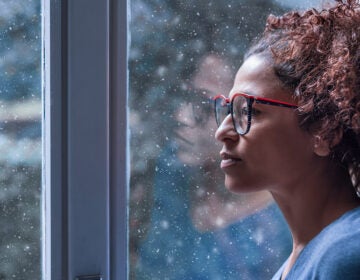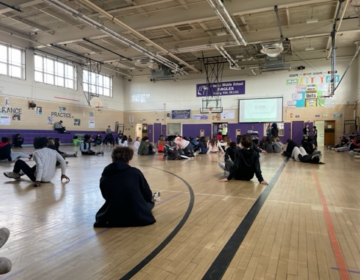How can therapy apps reach lower-income communities?
A Reno effort succeeded with people who’d done in-person therapy. But did it reach those who traditionally couldn’t afford in-person therapy?
Listen 7:16
Young woman using Mental Health Apps on cell phone.
This story is from The Pulse, a weekly health and science podcast.
Find it on Apple Podcasts, Spotify or wherever you get your podcasts.
Sarah Zobler found out about therapy apps in the most non-techy way possible: a billboard for Talkspace she spotted while driving through Reno, Nevada, where she lives.
“I knew therapy and I knew apps, but I had never even thought that such a thing existed,” Zobler said.
For Zobler, getting a therapist appointment in Reno was like pulling teeth. As a rabbi and a mother, it was hard to find time to commute to a therapist’s office. Apps offering virtual therapy, like Talkspace, claim to solve that problem.
They work like a matchmaking service. You download the app, give your therapist preferences, from gender to location, and the app will match you with therapists based on your preferences. Once you settle on a therapist, you can choose between plans allowing for video chat sessions or 24/7 text, video, or audio messaging. It’s like having a therapist in your pocket.
“I hit it off so well with the therapist on Talkspace that I stopped looking for an in-person therapist,” said Zobler. “I want my therapist to push and to be a sounding board, and she does that beautifully.”
However, Zobler’s therapist wasn’t the only thing drawing her to Talkspace. Since January 2021, Reno residents age 13 and up had free access to Talkspace for a year once they sign up.
The deal came together in December 2020. Reno’s mayor, Hillary Schieve, had actually been looking for a therapist for herself after the passing of both her brother and sister, only to find that appointments were all booked. She ended up using Talkspace instead.
At the same time, Reno was faced with a significant chunk of unused coronavirus relief money. Mayor Schieve decided to devote that money to mental health, entering talks with Talkspace and coming up with a plan: free Talkspace access for Reno residents age 13 and up. Residents had access to monthly video sessions and 24/7 video, audio or text messaging for a year.
Naturally, some residents who heard about the deal signed up right away.
“I suffer from depression that can get pretty severe at times, so therapy is a good supplement to my arsenal of normal mental health coping strategies,” said Sarah Richman. “I was actually in a position where I was looking for a new therapist because I had some funding barriers to my in-person talk therapy. So [the deal] was actually a very nice coincidence for me.”
The deal was great at reaching people like Zobler and Richman, who had used in-person therapy in the past. As for whether it was reaching communities that traditionally couldn’t afford in-person therapy, that was unclear. Several Reno Talkspace users said they were the only ones in their circle who even knew about the deal.
Subscribe to The Pulse
“I’m pretty puzzled by the fact that the city of Reno’s PR people aren’t pushing this more, because it’s a pretty cool program,” said Topher South, who took advantage of the Talkspace deal — and even recommended it to students at the learning center where he teaches. “There hasn’t been anything at all mentioned, no emails to the center like, ‘Hey, you! Mention this to your students!”
According to This is Reno, fewer than 1,400 residents were using the free service months after it had launched and about 3,100 people used the service before the year-long contract ended.
Getting virtual therapy to reach lower-income communities starts with reaching out to schools, urgent care centers, firehouses, and other neighborhood staples to spread the word about any affordable options.
“When you’re sitting in an emergency room, it may take hours for you to be seen,” said Terica Toliver, the director of teletherapy at innovaTel Telepsychiatry, who does virtual therapy exclusively. “Let’s utilize that time better. So, if they notice that this client may be dealing with depression, just being able to give them a resource: ‘Hey, have you thought about this? Have you checked this out? Do you know that the city is offering this service for free? And this is a way that you can access it.’”
That way, virtual therapy options are able to reach communities through people who regularly work with or in them.
“If [the city of Reno] had reached out to faith leaders, we would’ve been able to really get into lower-income communities in a very different way,” said Zobler, who works as a rabbi. “Had they just said, ‘Hey, can you circulate this resource to your people and have them just encourage their congregants that if they’re struggling to find a therapist, this is available?’ that would’ve been all over.”
Making virtual therapy accessible is one thing, but whether virtual therapy works is a case-by-case matter. Toliver said there are steps therapists can take to make virtual therapy as comfortable an experience as in-person therapy.
“Asking someone to take a shower, head across town, and come meet with a stranger that you don’t know — that’s a lot when you are balancing depression,” Toliver said.
By taking advantage of the fact that clients can get help from where they are comfortable, Toliver said, therapists can make virtual therapy a more comfortable experience for everyone.
“I’ve had clients that cannot get out of bed, and we’ve had a session right there, when they’re in bed,” said Toliver. “So it’s literally meeting the client where they are, but still giving the care that they need.”
WHYY is your source for fact-based, in-depth journalism and information. As a nonprofit organization, we rely on financial support from readers like you. Please give today.






